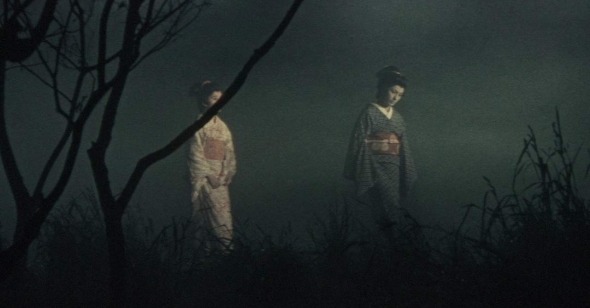Every Halloween, Reverse Shot presents a week’s worth of perfect holiday recommendations. Read past incarnations in our series “A Few Great Pumpkins.”
First Night:
Ghost Story of Yotsuya
One might think to willingly enter the world of fictional horror is to pursue fear, but for true fans of the genre it’s more complicated. We also crave catharsis, anxiety, frustration, and contemplation. The latter need indicates the stream of horror I find most gratifying, and perhaps best expresses why I return to horror stories, on screen or on the page, time and again, and why we continue this series of annual horror movie recommendations, now in its sixteenth year. A love of horror is, I think, a kind of solitude, and more philosophical than simply an engagement with one’s mortality: it reflects a willingness to give oneself over to moral allegory, one that helps make sense of flesh and blood reality. What can make one feel more alive than being able to reach out and touch the thin gossamer curtain that separates our world from the next?
The most frightful supernatural horror stories are frequently morality tales, of anguished states, of ghostly retribution, of intrusions unwanted yet spiritually invited. It’s often said in western culture that lapsed Christians make the best scary storytellers, but moral horror is international and nondenominational. Perhaps true lovers of scary stories believe in the possibility, yet remain skeptical, of a metaphysical extra-reality—a purpose and meaning and moral calculus behind everything, and the existence of good and evil. Among the greatest and most gorgeously savage of the horror moralists was Japanese director Nobuo Nakagawa. He is perhaps best remembered today for the delirious Jigoku, a movie so rabidly, delectably moralizing that it climaxes in an extended grand guignol vision of hell itself, detailing the gruesome, eternal torments its decadent, amoral characters, murderous yakuza and their bloodthirsty vengeance-seekers alike, must experience as punishment for earthly transgressions. Let that put the fear in you.
The unforgivingly color-drenched Jigoku was one of many films from 1960 that busted cinematic horror wide open, a year that included Hitchcock’s Psycho, Franju’s Eyes without a Face, Wolf Rilla’s Village of the Damned, Powell’s Peeping Tom, Bava’s Black Sunday, and John Moxey’s Horror Hotel, and pointed toward a new era of both permissiveness in gore and discomfiting psychological intensity. But just one year earlier, Nakagawa had directed a more traditional ghost story that was, in some ways, the stylistic equal of Jigoku and offered its own brand of gut-punch creepshow theatrics. Based on a famous, commonly adapted Japanese horror tale that had originated in Kabuki in the early 19th century, Ghost Story of Yotsuya is a classic tale of revenge from beyond the grave that was one of nine horror movies that genre journeyman Nakagawa made for Shintoho studio throughout the 1950s. In the various versions of the Yotsuya ghost fable there have been crucial character and plot differences, yet the main thrust remains the same: a lowly, masterless ronin named Iemon, treacherous in his own right yet also under the influence of an evil Iago-like sidekick Naosuke, wishes to divorce the poor, innocent Oiwa for a younger woman; with Naosuke’s guidance, he decides to frame her as an adulteress before murdering her with disfiguring poison. It will come as no surprise that Oiwa returns to earth as a furious avenging spirit.
Among the story’s earlier adaptations was an extended 1949 version directed by the great Keisuke Kinoshita, separated into two feature-length films. Taking the form of a more traditional supernatural melodrama, Kinoshita’s black-and-white version luxuriates in the characters’ wayward and tragic lives and offers more detailed psychological nuance that makes the murder of Oiwa all the more devastating and lends her return, in part two, a degree of poignancy. In contrast Nakagawa, in 75 fleet and nasty minutes, forgoes pathos. In the very first scene, Iemon (Shigeru Amachi) accosts Oiwa’s father to ask for her hand in marriage; refused for his bad reputation, Iemon immediately kills him and his brother, with a little help from Naosuke (Shuntaro Emi). The murderer summarily marries Oiwa (Katsuko Wagasuki) anyway, lying to her that he will track down and avenge “those” who killed her father.
The loveless marriage that ensues is in some ways as harrowing as the many deaths that spatter the film; there is no expression of genuine love between any two people, just a series of self-interested maneuvers and painful deceits. Men are callow, brutish, and given to thoughtless, instant bursts of violence; women are their victims—at least as long as they have human bodies. This is an irredeemable world, and only in some unknowable afterlife can wrongs be righted. Any satisfaction one can receive as a viewer is in witnessing the wicked get punished. And once it happens, it’s all over, as quickly and tersely as it began.
There is a dastardly cruelty to Oiwa’s sad death that makes Ghost Story of Yotsuya particularly heartrending; murdered by slow-acting poison that all but mutilates her beautiful face before she finally succumbs, Oiwa holds her baby in her arms as she gradually realizes what has happened to her, and that her husband is her killer. Nakagawa is such a pitiless filmmaker that even the return of Oiwa is devoid of the traditional relish that should come with tales of violent reprisal. Most often Oiwa appears in the terrible, gory shape in which she was dispatched, her body nailed to a board and sunk to the bottom of the river, her face distorted and misshapen from the poison and her hair and clothes soaked from her underwater grave. Nakagawa’s expressionist greens and oranges highlight Oiwa’s terrifying demonic force, allowing us to momentarily feel Iemon’s fear, putting us in the uncomfortable position of identifying with a murderer, no matter how much we know he deserves the grim death that’s coming to him.
This phantom appears upside down on the ceiling, beckons silhouetted from behind screen doors, or bubbles to the surface of a bog. Oiwa is hardly a prim and proper ghost with a message to deliver: she’s a nightmarish, unsettled form, bloodied, haggard, and single-minded, no longer a person but a manifestation of her rage and Iemon’s guilt, unrecognizable from her former self. Nevertheless, in the masterfully wretched universe spawned by Nobuo Nakagawa, she makes for rather great company. — Michael Koresky
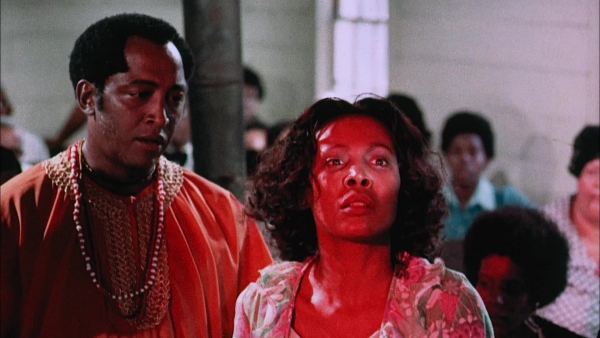
Second Night:
Lord Shango
If Black horror cinema can reasonably (if incompletely) be characterized at all, it is by the primal divide between the spirituality practiced by our ancestors and the religion of our oppressors. Much of the Black presence in American horror finds its origins in white anxieties around the religion of the slaves, a poetic union of the beliefs they carried with them from their homelands mixed with indigenous as well as European folk tradition. In many ways, the story of Black life in America is a story of faith, in all its promises and limits, an enduring embrace of the unknown.
Lord Shango (1975), directed by Ray Marsh from a screenplay by Paul Carter Harrison (the noted Black playwright and professor whose protégés included sisters Phylicia Rashad and Debbie Allen), opens with the pelting of drums cut short by lively gospel music, establishing the film’s central conflict. At some point, it was released under the puzzling title The Color of Love. The entire cast is Black, and despite two or three romantic interests (for one of them dies early on), the main love story is between a mother and daughter; but if love has any color in the film that color is red. Whole scenes are bathed in it: the neon red that floods the nightclub scenes, bloodred face paint worn by the mysterious followers of a local religious sect, or the crimson wax candles carved into human models whose kindling casts a red glow over the dark bodies doubling them. Red, of course, is the color of blood, and the film is appropriately preoccupied with all its implications.
Shot in Friendsville, Tennessee, among the bucolic grassy knolls and dusty roads so characteristic of the pastoral, prayerful South, the film stars Marlene Clark as Jenny, a single mother to teenager Billie (Avis McCarther). Jenny longs for another child, and at the behest of her pathetic boyfriend, Memphis (Wally Taylor), agrees to have herself and Billie baptized. But Billie’s boyfriend, Femi (Bill Overton), belongs to a Yoruba religion, widely taken for voodoo in the film’s reviews. When he disrupts the proceedings, the reverend, along with some church elders—including Memphis—forcibly attempt to baptize Femi and end up drowning him in the process. Later, a distraught, bed-ridden Billie begins having visions of Femi and one night, while her mother is out working, she mistakes Memphis for her dead lover. After Jenny discovers her boyfriend slept with her daughter, she denounces Christianity and kicks Memphis out, only to realize that Billie has run away. Jenny then seeks out the Yoruba clan to find her.
Clark is best known for her frankly unforgettable turn as the elegant and spirited Ganja Meda in Ganja & Hess (1973), although she boasts a fascinating horror pedigree beyond this, even if none of those films ever touched Bill Gunn’s masterpiece. Before the close of the seventies, she would also appear as the chic wife of a wealthy Black hunter trying to locate the werewolf in their midst in The Beast Must Die (1974), in addition to unsuccessful ventures Night of the Cobra Woman (1972) and Black Mamba (1974), where she plays a snake-shifting succubus and witch, respectively. The striking beauty made her start as a model and emerged on-screen a naturally regal performer—never haughty or cold—but playfully, perhaps petulantly so, as if all that dignity merely veiled a youthful incandescence. Even so, she convincingly portrays a jaded, desperate mother in Shango, despite being two years younger than the actress playing her daughter.
The film never quite achieved the same cultural status as admittedly more dynamic blaxploitation exports like Blacula (1972), its sequel Scream Blacula Scream (1973), or Dr. Black, Mr. Hyde (1976). But Shango is also not straightforwardly horror, although it involves the dead, their hauntings and resurrections. It is foremost a thoughtful melodrama, distinctly progressive in the way it considers the role of religion in Black communities, and in portraying men as Bible-thumping guardians of patriarchal ideologies also capable of murder and the most perverse sexual transgressions. Scenes of the Yoruba ceremonies—with intimate, prolonged closeups on the worshippers—are among the film’s strongest and are mindful of the legacy of voodoo as spectacle in Hollywood fare such as Black Moon (1934) or I Walked with a Zombie (1943), where these communities and rituals were inevitably sexualized. No doubt, the rise of Afrocentrism deeply influenced the filmmakers’ approach; thus it ends on a politically conscious, if unshakably eerie note that seals the film within a Black horror tradition where the corporeal never stood a chance against the spirit world. —Kelli Weston
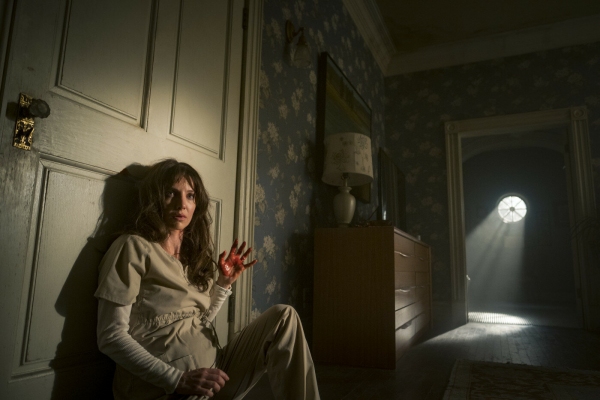
Third Night:
Malignant
The two 2021 features that in retrospect I most wish I had seen theatrically were Old and Malignant, both of which happen to feature the kind of squishy body horror that reduces—or giddily transubstantiates—audience members into paroxysms of gasping, disbelieving laughter. If M. Night Shyamalan’s film is arguably the greater artistic achievement, James Wan’s thriller is probably the bigger hoot, and equally an auteur piece down to the last ghastly millimeter. Somewhere in the first half hour, after I’d figured out why poor, abused, tragically miscarriage-prone Maddie (Annabelle Wallis) kept having Eyes of Laura Mars–style visions placing her at the scenes of various heinous crimes—which is to say long before the script’s official revelation—I flashed back, happily, to Wan’s 2007 ventriloquist-core thriller Dead Silence, with its EC Comics smorgasbord of helpless, fleshy marionettes: what better way to satirize the idea of genre director as puppet master than to simultaneously literalize it through an allegory about malevolent forces jerking our strings?
Malignant’s sadistic exuberance begins with the title, which tips the Big Twist through its wry use of a clinical vernacular. So, spoiler alert: it turns out that, contra Arnold Schwarzenegger in Kindergarten Cop, it is a tumor—“it” being Gabriel, an anthropomorphic teratoma representing Maddie’s deformed (and, of course, evil) Siamese twin brother. After lying dormant for a couple of decades sewn up into the seams of his sister’s skull, Gabriel has been unleashed by an act of blunt force head trauma, using Maddie as a vessel for revenge against the doctors behind his surgical imprisonment while also getting in his licks against a host whose life to date has been lived in a state of oblivious psychic repression as to his very existence. “I didn’t ask to be tethered to you,” Gabriel rages late in the film. “You don’t deserve your body. I can use it better than you.”
It’s always nice when a movie delivers on its dialogue, and the late-breaking, knowingly gratuitous set piece in which Malignant’s villain makes good on his claim has already launched it into the cult-film stratosphere, melding the kinetic kick of wire-work-style wuxia with wonderfully chunky gore. In an overpriced hire job like Aquaman, Wan submitted to the crass temptations of wall-to-wall CGI, but, befitting a movie that wears its polyglot, Psychotronic-cinema influences on its sleeve, Malignant features a mix of digital tricks, old-school prosthetics, ingenious animatronics, and virtuoso physical acting, the latter courtesy of contortionist Marina Mazepa. As counterintuitive as it may be to deconstruct the technique behind Gabriel’s rampages, it strikes me that the collaborative effort to bring this particular monster to life—including also Wallis’s perpetually spooked performance as a woman coming to terms with an imaginary frenemy—recalls the process behind The Exorcist’s Pazuzu, and while Wan and his co-writer Ingrid Bisu are working in a completely different tonal and thematic register than William Friedkin (their anxieties are biological, not theological), there’s an inheritance of the earlier filmmaker’s shameless showmanship.
“There are only three reasons to go to the movies,” Hurricane Billy once opined: “to laugh, to cry, or to be scared.” I’m not sure Malignant necessarily bats better than one for three on this count, but by so thoroughly blurring the lines between hilarious and grotesque—and making an honest, if again, shameless, attempt at emotion through the methodical terrorization, instrumentalization, and emancipation of its existentially snake-bitten yet admirably resilient heroine—it transcends the percentages. —Adam Nayman
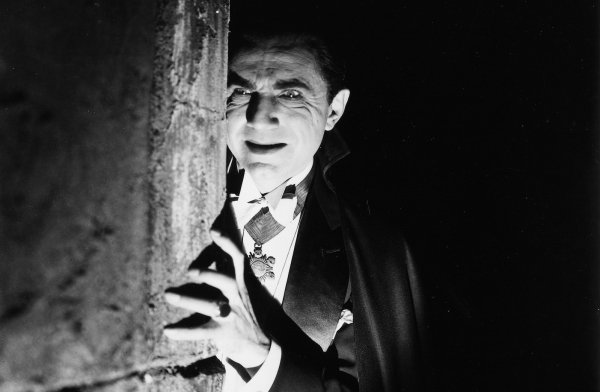
Fourth Night:
Dracula
A Hungarian in a black high-collared cape, black hair slick and gleaming in the flicker of a candle, terribly pale and sinister in his rigid posture, descends the great gothic stairs and the words pour out in an exotic accent: "I am . . . Dracula." It's a simple sentence, yet how it chills, how it seduces. Ninety years later, Tod Browning's Dracula (1931) feels, at times, almost airless, pervaded not with unmitigable dread but a stifled mustiness. Save the squeak of rubber bats bobbing by the window and the sumptuous swell of the Swan Lake theme playing over the opening credits, Dracula is a quiet movie for the first 20 minutes, with long periods of sibilant silence smothering the viewer. Then it transmogrifies, like Dracula himself, into something more loquacious, with a lot of stagy prattling. Yet it's the count's hypnotic entrance—the striking stillness, the dichotomy of Lugosi's pallor and the inky blackness surrounding him, a well-groomed revenant—that ushered in a new era of horror.
The Universal monster movies are triumphs of practical design work. Think of Dracula's castle, sublimely decrepit, giant gray walls adorned with decorative spider webs, or Frankenstein's mad scientist laboratory, with metal apparatuses and chains and dungeon walls and lightning wrapped around a spire. Think of Karloff's flat top perched on a neanderthal brow. Dracula, made for around $341,000, is a feat of design more than directorial dexterity. The costumes were designed by Ed Ware and Vera West, and the sets by Russel A. Gausman. Cinematographer Karl Freund—who pioneered the roving, roaming camera; shot German Expressionist films The Golem (1920), The Last Laugh (1924), and Metropolis (1927); would go on to direct The Mummy (1932) and Mad Love (1935); and, in a change of pace, act as cinematographer for I Love Lucy in the fifties—was given great freedom by Browning, making him a sort of uncredited second director. Dracula may lurch at times, and the dialogue may have that stand-in-the vicinity-of-the-mic stiltedness, but the film looks great. The pristine white of the wives' dresses dragging on the floor behind them, the whorls of fog enfolding the castle, the shadows swallowing rooms.
Carl Laemmle Jr., son of Universal founder Carl Laemmle, took over the company in 1928 and remained head of production until 1936. Though the company had early hits with King of Jazz and All Quiet on the Western Front (both 1930), the monster movies would define Laemmle's tenure and become inextricably associated with Universal. Dracula, their first horror movie, is based not on Bram Stoker's epistolary novel but the stage play by Hamilton Deane and John L. Balderston. Before Laemmle reluctantly cast Lugosi (who originated the role on stage), he had considered a litany of other actors, including Ian Keith, Paul Muni, Chester Morris, John Wray. Lugosi helped make Laemmle. Whereas the vampire from Murnau's Nosferatu is an unholy abomination, a thing more than a man, with long curling claws and dilapidated fangs, Lugosi has suavity, a frightening serenity. It's Bela Lugosi's otherness, his odd enunciations and the hint of lasciviousness, that stiletto stare, that imbues the film with calm menace; it's Lugosi's face that festooned posters, Lugosi's silhouette that remains the inspiration for a century of mannerly vampires. Consider Christopher Lee, insidiously handsome and eloquent; or Frank Langella, the gentleman's vampire; or Gary Oldman crossing oceans of time to find the reincarnation of his long-lost love. There's a hint of Lugosi in all of these; all modern monsters are his progeny. —Greg Cwik
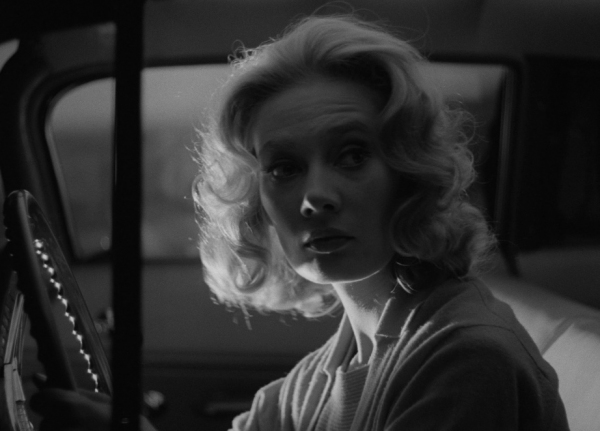
Fifth Night:
Carnival of Souls
The sun was setting as Herk Harvey drove along a stretch of arid highway near Salt Lake City. In the distance, he spotted an abandoned, turreted building: the remnants of the Saltair Resort, a decrepit early-20th-century amusement park. The sight prompted him to place a call back to John Clifford—his screenwriting partner at Centron, an educational-film production company in Lawrence, Kansas—and suggest they make a horror film prominently featuring these decaying ruins.
Harvey replicates this experience in 1962’s singular, unshakeable Carnival of Souls, his sole feature narrative in a career mostly of short films made for Centron. As organist Mary Henry (Candace Hilligoss) drives this very same Utah route, her car radio picks up an echoey organ theme that seems to conjure the silhouette of Saltair’s central promenade, which resembles a distant mesa in the sunset. Reflected in the passenger window is a ghostly man (an uncredited Harvey) who will pursue Mary for the rest of the movie: his pancake-white face is lit from below with a single, harsh beam of light.
Although Carnival of Souls is legendary as a shoestring production—made on a $30,000 budget, largely with a cast and crew of Centron-adjacent Kansans—its atmospheric sophistication has aged well, heavy on ambiguous unease. Harvey envisioned the story as a dreamy blend of Cocteau and Bergman, and the film shares an enduring elementality with the work of those filmmakers. One would hardly expect a shot of a building to have such sensory impact, but Saltair brings a unique history along with its appearance. Originally constructed in 1893 by the Church of the Latter Day Saints, Saltair was once a huge regional attraction, a wholesome “Coney Island of the West.” Although the main pavilion burned down in 1925, it was hastily reconstructed by new management who pivoted it into a music hall. In this era, Saltair 2.0 boasted the largest dance floor in the world and hosted bandleaders like Glenn Miller and Tommy Dorsey, but after another fire, the venue quickly fell into disrepair once again. The forces pulling Mary back to the resort are part of this doomed cycle of birth and destruction.
When Mary sees Saltair for the first time, she’s trying to escape her own present. Carnival of Souls begins with a freak drag-racing accident: after a car dramatically pirouettes off a bridge and plummets into the river, Mary is the only one of its three young passengers to survive, stumbling out of the water in a shell-shocked daze. (Clifford was once, incredibly, songwriting partners with Angelo Badalamenti, so the scene likely influenced Ronette Pulaski’s walk over the bridge in the Twin Peaks pilot.) It’s an odd twist of fate that she even found herself in this situation; before the race began, Mary’s eyes darted toward the passenger window as if she wanted to jump out of it. Hoping to tune out the trauma of the crash, she finds work as the lead organist at a church in Salt Lake City, but despite her chosen musical instrument, she is not religious. Although this choice distresses—even offends—everyone she meets, she prefers to politely keep to herself.
A popular interpretation of the film is that Mary is in purgatory, which manifests as her physical and emotional severance from the living. While shopping in a department store, she calls out to a salesperson and finds that no one can hear her; Harvey drowns out all ambient sound beneath the carnival organ theme. But even if she wanted to join in, Mary finds herself among a ragtag group of lonely eccentrics. Mary’s boarding-house owner is an old woman with oddly paced speech—after Mary spots the Saltair ghost in the stairwell, Harvey inserts an awkward, unnerving shot of the proprietor insisting “there’s nobody there” while darting her eyes furtively to the side. Kindly as she is, she’s not a peer. For that, look no further than Mary’s fellow boarder, John, who self-medicates his solitude with alcohol and traffics in bizarre wisecracks that might be endearing if he weren’t a leering creep. A man named Dr. Samuels finds Mary in a panic after she mistakes someone in the park for a ghost, and he tries to elucidate the roots of her guilt—but he soon clarifies that he is not a psychiatrist after endless attempts to psychoanalyze her. Everyone is, if not literally threatening, a bit off-kilter, creating an atmosphere that could only lead to Mary’s isolation; even religion seems a false, lonely promise of salvation.
The inescapable fact of her alienation constantly plays across Lee Strasberg–trained Hilligoss’s expressive, alert face. Beyond her suppressed trauma, we’re only certain that she’d like some sort of peace. In a sense, she finds that calmness at Saltair, a place that pushes the idea of “resting in peace” to its existential limit; after all, it sits close to the Great Salt Lake, often referred to as “America’s Dead Sea.” As Mary wanders the structure, she’s struck by the void of life within its grandeur: a magic carpet slides out of nowhere down a metallic slide, while old advertisements for the beach call out to leisure-seekers from half a century ago. The promenade is haunted by nothing more sinister than the amusement that briefly thrived there—a parallel, perhaps, with the death-defying thrill of Mary’s initial drag race. Even the liveliest boardwalk will one day become driftwood.
So, when the ghosts finally claim Mary, the silence that follows is most chilling. The chase that leads up to her disappearance is terrifying: Harvey alters the frame rate and elevates their ghoulish laughter in the mix, and the phantoms glide out of the water in scenes later quoted in The Shining and Apocalypse Now. After the ghosts swarm Mary on the sand, the scene cuts to black, her vision swiftly extinguished. Her remains are released back to the car in Kansas, but the final trace of her stay in Utah is her handprint on the sand—which, like the ash-bound pavilion, is soon to be swept away by the Earth. —Chloe Lizotte
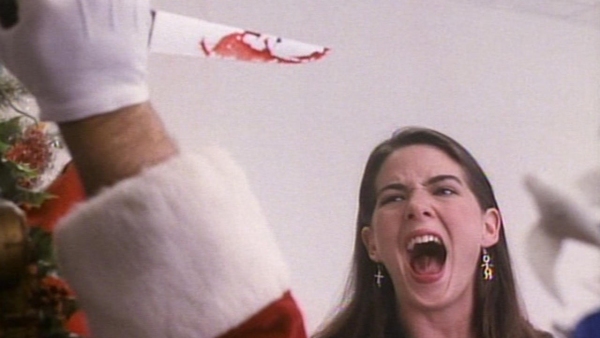
Sixth Night:
Silent Night, Deadly Night 3: Better Watch Out!
Full disclosure: I have seen neither the first nor second film in the Silent Night, Deadly Night series. Nor the fourth. Nor fifth. I came to 1989’s Silent Night, Deadly Night 3: Better Watch Out! only at the conclusion of an auteurist round-up undertaken in the wake of director Monte Hellman’s passing earlier this year. The film’s provenance as a direct-to-video cheapie suggested maintaining low expectations, but Hellman’s own claim that the finished film showcased some of his best work was intriguing. His pictures from elliptical late ’60s westerns Ride in the Whirlwind and The Shooting, through the epochal road trip Two-Lane Blacktop, and on to underseen later ’70s glories Cockfighter and China 9, Liberty 37, make for one of the most idiosyncratic and satisfying runs in American movies. Even if Silent Night’s reputation isn’t great, I assumed there had to be something in it.
Here, we find an impassioned Frankenstein-esque medical researcher, Dr. Newbury (Richard Beymer, Twin Peaks’ Ben Horne, so game for this role that he treats each increasingly ridiculous monologue like it was Shakespeare) trying to connect a young, blind psychic named Laura (Samantha Scully) to the comatose murderer of the series’ second installment, Ricky (Bill Moseley), via her dreams. It seems the doctor is successful: when the girl falls asleep on his exam table, she sees visions of older events, lifted, I assume, directly from previous installments of the Silent Night series. One of the sequences hilariously involves Santa being shot to death in front of a passel of shocked children. Laura lies to Dr. Newbury about what she’s experiencing when she awakens, but a single tear forming at the corner of Ricky’s right eye suggests something has been stirred.
This being a Christmas-themed franchise, the film is naturally set on December 24th. Laura is in a hurry to get the dream experiments over with so she can head to Granny’s house with her brother Chris (Eric Da Re, also soon to star in Twin Peaks), who has his new girlfriend, Jerri (we know her as Mulholland Dr.’s Laura Elena Harring, but here she’s credited as simply Laura Herring), who looks uncomfortably like his sister, in tow. As the three head up to the homestead, Ricky awakens, wreaks gory havoc in the hospital, including filleting a drunken Santa, and executes ever more ingenious gambits to track down Laura. For a man missing the top half of his skull and whose exposed brain is protected only by some sort of glass bowl filled with blood, he’s a surprisingly deft hitchhiker.
The film opens with a lengthy close-up of Laura that holds, before tracking back to a medium, a common Hellman start. The cutting throughout is considered and sharp—Silent Night features more than a handful of lingering close-ups of faces, eerie frames that last long enough to make one fear what the next shot might bring into view. And, throughout, Hellman stretches and pulls at time—dropping into a scene far later than you’d imagine, letting another linger longer than it seems possible—which casts a film one might expect to be tightly wound in an oddly oneiric haze. The oddity here grants him latitude. There are strange scenes that shouldn’t work in any reasonable movie, but here they just…do. Witness Granny opening the door to Ricky, inviting him in, serving the stranger dinner, and offering him a present before he murders her. Hellman even slyly drops in a hint of self-referential humor: a horny, soon-to-be-murdered gas station attendant watches The Terror in black-and-white on a small tube set, which Hellman directed portions of.
That said, making too many grand claims for Silent Night, Deadly Night 3 does it no favors. Like so many slasher flicks (and near every Pixar film), this particular contraption climaxes with extended bouts of running and falling and screaming. Many of the protagonists are stabbed, which grows tedious. A showdown in a dark basement that should have provided sightless Laura an advantage over her stalker is staged with impressive brio while simultaneously being nonsensical and completely unsatisfying. Cheesy synth overwhelms the soundtrack with tinny ominousness. And Hellman might have been better served (and more fully pointed the way towards Mulholland Dr., with which this film shares some tonal kinship) by switching his lead actresses and placing Herring at the center.
To return to Hellman’s own assessment of the film, let us note that he doesn’t label the finished object a personal best, but he focuses on the quality of the labor, the process. His team worked fast and efficiently, moving from concept to production to post to screen in a few months. I wonder if making this reminded him of his start: Beast from Haunted Cave for Roger Corman’s New World Pictures.
Hellman made too few movies, but looking back over his career, the ones he made all, as motley a bunch as it is, seem like the right ones. He had a talent such that that somehow, after his long break from filmmaking following China 9, he could return a decade later and give us, back-to-back, Iguana and Silent Night, Deadly Night 3 and make them feel somehow of a piece, part of a larger project undertaken across his body of work. Though Silent Night, Deadly Night 3: Better Watch Out! is his only overt stab at the horror genre, think back on the unease and violence laced throughout his career. Though he has said he doesn’t like scary movies, he’s perhaps, secretly, one the greatest American filmmakers for the Halloween season. —Jeff Reichert
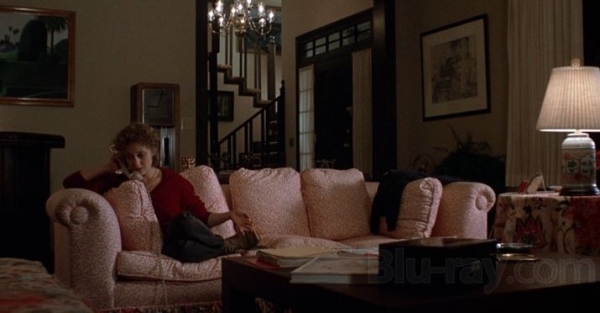
Seventh Night:
When a Stranger Calls
Whether using words like “shivery” or “hair-raising” or “revolting,” the way we try to describe the feeling of horror is often inadequate. This is after all a genre that depends on intangible, personal emotional effects. This is especially true because of horror’s reliance on the uncanny: in brief, the decentering intrusion of the strange into the otherwise familiar. Whether we take the Freudian definition (related to strange everyday events that trigger something in the unconscious otherwise repressed) or that of fiction theorist Tzvetan Todorov (when an otherwise realistically constructed world strays beyond what we know to be possible or explainable), the uncanny effects of horror seem to be boundless, irreconcilable, and, I think, highly individualized.
For me, horror and nostalgia feel entirely bound together, and I doubt this wouldn’t be the case for many. The destabilizing effects of horror are related to a conception of the past—personal and collective—as much as a fear of change (death). No art form better allows us to enter the past than cinema, an uncanny form in its very being for the way it shows us something familiar (the world as we know it) yet estranging (the world is unreproducible) at all times. Horror, intending to produce involuntary “chills” in the viewer, only heightens the effect of cinema’s already eerie ontology.
This is all perhaps an overwrought introduction for discussion of a film as humble as When a Stranger Calls. A viewer’s relative response to this 1979 thriller—a once-upon-a-time box-office hit perhaps more referenced and imitated than actually watched today—depends, I suspect, on a certain proximity to the material. Produced and released the year I was born, Fred Walton’s stalker thriller thrusts me immediately back to a time and place that look familiar, an era that I only think I understand and that I only pretend is mine. The tactility of the furniture and interior design; the relatability of the architectural layout of the homes; the intimacy of its props and objects (most crucially, corded, rotary telephones); the preponderance of actors who appeared in so many of the movies (the dreams and nightmares) of my childhood viewing: these are not trifling or superficial matters but the heart of it, and I imagine more or less true for any viewer of any generation looking at a regional, historical, or otherwise textural facsimile of their childhood—the dreaded feeling of having been there and not been there at once.
It’s the first 22 minutes of Walton’s film that everyone recalls first—an elegant evocation of the old (sub)urban legend of the babysitter harassed by a phone caller exhorting her to “check the children,” only to have the police trace the call and inform her that “the call is coming from inside the house!” As played by Carol Kane, in what only now would be called against-the-grain casting, the tormented Jill Johnson is a completely believable and relatable victim of this psychological terrorizing, which Walton augments with a series of ominous cutaways (a grandfather clock’s swinging pendulum) and savvy fake-outs (a startling sound from the kitchen turns out to be the freezer’s icemaker). In its odd tranquility and growing sense of imminent peril, its shots of shadowy empty rooms and untended-to objects and furniture, this first sequence portends The House of the Devil, the 2009 Ti West horror throwback that emphasizes the terror of “nothing” (what the great ghost story writer M. R. James might call “The Malice of Inanimate Objects”), allowing the sinister presence of period décor to do a lot of the heavy lifting. By the time Jill discovers the horrible truth of the source of the call—confirmed in just a low-angle shot of the children’s bedroom door opening, a shaft of light hitting the top of the staircase landing—and must escape, it’s almost a disappointment to leave the house, and all this well-maintained atmosphere, behind.
In an exceptional example of cinematic “if it ain’t broke, don’t fix it,” this entire opening is a replication of Walton’s own 1977 short The Sitter—also 22 minutes—right down to the inexplicably ghastly freeze-frame-and-zoom shock effect when Jill opens the front door to find a detective waiting, eerily still and scowling. In the feature, that face belongs to Charles Durning, whose recognizability perhaps lessens the moment of terror while indicating that the narrative is far from over. Yet other differences are worth pointing out, as they express how much architecture and setting are key to one’s emotional response to horror: chief among these is that in the short, the living room is a more wide-open space with less shadowy, hidden corners (which makes Jill, played here by the more believably teenage Lucia Stralser, seem more vulnerable) and is most memorable for its wall-to-wall red carpet (foreshadowing the caller’s eventual taunt that he wants “her blood”). While the sequence in When a Stranger Calls is acted, shot, scored, and edited with more refinement, the simplified, at times jarringly amateurish feel of The Sitter indicates a certain purity of intent that’s perhaps even more terrifying, down to its nastily abrupt ending: the kids had been dead in their beds for hours. (Apparently, The Sitter showed in theaters before certain screenings of the singularly horrific Looking for Mr. Goodbar—can you imagine that night out?)
Lest you think my response to the specific layout, feel, and texture of When a Stranger Calls, and my evaluation of it in comparison to The Sitter, is an articulation of pure nostalgia, I should now add that I just watched When a Stranger Calls for the first time in preparation to write this. Yet, when I finally watched The Sitter (last Halloween) and When a Stranger Calls (this Halloween), I felt like not only had I seen them before but also that I had been in these rooms. An almost eye-wavering sense of déjà vu came over me, as though they have been a part of my childhood, perhaps by virtue of the twice-told tale itself, but more specifically the tingling sense it imparted of having sat on those couches, walked on those carpeted floors, dialed and clutched those rotary phones—all of which take on a simmering danger in Walton’s world. (It’s worth noting that one of Walton’s later projects was the pilot of the 1985 reboot of Alfred Hitchcock Presents, which remade the classic 1965 Alfred Hitchcock Hour episode “An Unlocked Window”—maybe the best “the killer is already inside the house!” narrative of them all.)
From what I’ve gleaned about When a Stranger Calls, it seems as though many acclaim the opening sequence for its traditional horror beats and elegant construction but find the remainder of the film—set seven years later, after the killer, Curt Duncan (an effectively haunted Tony Beckley, who died six months after the film was released) escapes from a mental institution—wanting for scares. I’m glad to report that I found the entirety of the film pretty captivating: Walton ruthlessly exploits our fears (a throwaway shot near the beginning of kids being carried downstairs in body bags) while also maintaining a surprising humanity (a later image of a supporting character tenderly picking up and hugging his baby from the crib when he’s reminded of Duncan’s murders from years ago). There’s a free-flowing sense of menace maintained throughout, which is more nuanced than the opening barnburner might suggest.
When a Stranger Calls is a tactile experience that jingle-jangled my particular pleasure centers not just with its architecture and design but also the appearance of so many standout character actors that lined the cinematic crevices of my childhood: the redoubtable Durning as the police detective turned private eye driven to catch the killer (so driven that at times he becomes a menacing figure himself), Rachel Roberts as an imperious psychiatrist, Ron O’Neal as Durning’s sympathetic former partner, and, perhaps best of all, the great, smokey-voiced Colleen Dewhurst as a downtown L.A. barfly with whom Duncan enacts an oddly touching yet highly menacing game of cat-and-mouse. (They meet at the no-longer extant Torchy’s Bar, shown in exterior shots, a landmark also recognizable from Walter Hill’s 48 Hrs.) Entirely unpredictable as ever, Dewhurst, introduced in astonishingly beautiful profile at the bar, is flirtatious and inviting, rejecting and cold, stern and apologetic, all at once and often even in the same line delivery. Duncan follows her home to her lonely city apartment, and she relievedly manages to goad the queer duck back into the hallway—though in a terrifically unsettling touch, he doesn’t quite close the door on the way out, leaving her to gingerly lock up and latch the chain herself. And exhale.
It’s this attention to detail, the tiny gestures that create unbearable suspense, that make When a Stranger Calls so supremely frightening, even before it returns in the final stretch to the traumatized Jill for the last—extremely effective—scare. That the film has Duncan track down and terrorize Jill again doesn’t make a lot of sense, but its pleasing narrative symmetry overcomes logic. The structural simplicity—the return to the space of the suburban home after the urban, De Palma-like stalkings that make the bulk of the film—speak to a central tension in horror itself, between the fear of what’s already inside and what may be coming from outside, the known and the unknown, the tactile and the inchoate. The uncanny exists somewhere between the two. Either way, the killer has already found his way in. —Michael Koresky
